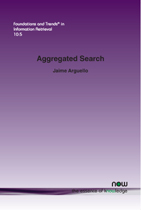Aggregated Search
By Jaime Arguello, University of North Carolina at Chapel Hill, USA, jarguello@unc.edu
Abstract
The goal of aggregated search is to provide integrated search across multiple heterogeneous search services in a unified interface—a single query box and a common presentation of results. In the web search domain, aggregated search systems are responsible for integrating results from specialized search services, or verticals, alongside the core web results. For example, search portals such as Google, Bing, and Yahoo! provide access to vertical search engines that focus on different types of media (images and video), different types of search tasks (search for local businesses and online products), and even applications that can help users complete certain tasks (language translation and math calculations). Aggregated search systems perform two mains tasks. The first task (vertical selection) is to predict which verticals (if any) to present in response to a user’s query. The second task (vertical presentation) is to predict where and how to present each selected vertical alongside the core web results. The goal of this work is to provide a comprehensive summary of previous research in aggregated search. We first describe why aggregated search requires unique solutions. Then, we discuss different sources of evidence that are likely to be available to an aggregated search system, as well as different techniques for integrating evidence in order to make vertical selection and presentation decisions. Next, we survey different evaluation methodologies for aggregated search and discuss prior user studies that have aimed to better understand how users behave with aggregated search interfaces. Finally, we review different advanced topics in aggregated search.
Aggregated Search
The goal of aggregated search is to provide integrated search across multiple heterogeneous search services in a unified interface—a single query box and a common presentation of results. In the web search domain, aggregated search systems are responsible for integrating results from specialized search services, or verticals, alongside the core web results. For example, search portals such as Google, Bing, and Yahoo! provide access to vertical search engines that focus on different types of media (images and video), different types of search tasks (search for local businesses and online products), and even applications that can help users complete certain tasks (language translation and math calculations).
This monograph provides a comprehensive summary of previous research in aggregated search. It starts by describing why aggregated search requires unique solutions. It then discusses different sources of evidence that are likely to be available to an aggregated search system, as well as different techniques for integrating evidence in order to make vertical selection and presentation decisions. Next, it surveys different evaluation methodologies for aggregated search and discusses prior user studies that have aimed to better understand how users behave with aggregated search interfaces. It proceeds to review different advanced topics in aggregated search. It concludes by highlighting the main trends and discussing short-term and long-term areas for future work.
